US education and Chinese education
中国教育发展历程及现状英语作文
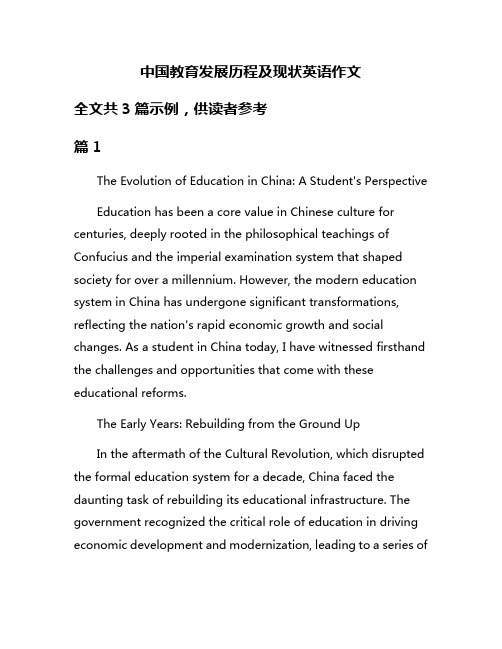
中国教育发展历程及现状英语作文全文共3篇示例,供读者参考篇1The Evolution of Education in China: A Student's PerspectiveEducation has been a core value in Chinese culture for centuries, deeply rooted in the philosophical teachings of Confucius and the imperial examination system that shaped society for over a millennium. However, the modern education system in China has undergone significant transformations, reflecting the nation's rapid economic growth and social changes. As a student in China today, I have witnessed firsthand the challenges and opportunities that come with these educational reforms.The Early Years: Rebuilding from the Ground UpIn the aftermath of the Cultural Revolution, which disrupted the formal education system for a decade, China faced the daunting task of rebuilding its educational infrastructure. The government recognized the critical role of education in driving economic development and modernization, leading to a series ofinitiatives aimed at expanding access to primary and secondary education.One of the most significant achievements of this period was the implementation of the Nine-Year Compulsory Education Law in 1986, which made nine years of schooling mandatory for all children. This policy, combined with significant investments in school construction and teacher training, helped to increase literacy rates and lay the foundation for a more educated workforce.The Rise of Higher EducationAs China's economy continued to grow and integrate with the global market, the demand for skilled professionals and advanced degrees skyrocketed. In response, the government embarked on an ambitious plan to expand and reform the higher education system.The late 1990s and early 2000s witnessed a rapid growth in the number of universities and colleges, with new institutions being established across the country. This expansion was accompanied by efforts to improve the quality of education, including the introduction of more rigorous admission standards, updated curricula, and increased research funding.As a high school student during this period, the prospect of attending university became increasingly competitive but also more accessible to those from diverse socioeconomic backgrounds. The government implemented policies to support students from rural and underprivileged areas, offering financial aid and scholarship opportunities to promote educational equity.Embracing Globalization and International CollaborationWith China's growing presence on the global stage, the education system has also adapted to prepare students for an increasingly interconnected world. International exchange programs and partnerships with foreign universities have become commonplace, allowing students like myself to gain exposure to different cultures and educational approaches.Many universities have established joint degree programs with prestigious international institutions, enabling students to earn degrees recognized globally while studying in China. Additionally, the government has actively recruited foreign experts and scholars to teach at Chinese universities, enriching the academic environment with diverse perspectives.The Integration of TechnologyOne of the most significant developments in Chinese education has been the rapid integration of technology into the classroom. From interactive whiteboards and online learning platforms to virtual reality simulations and AI-assisted tutoring, digital tools have transformed the way we learn and engage with educational content.During the COVID-19 pandemic, the adoption of online learning accelerated out of necessity, showcasing the potential for technology to transcend physical barriers and provide educational opportunities to students in remote areas. However, this transition also highlighted the digital divide and the need to ensure equitable access to technological resources across different regions and socioeconomic groups.Challenges and Ongoing ReformsDespite the remarkable progress made in recent decades, the Chinese education system still faces several challenges that require ongoing attention and reform efforts. One of the most pressing issues is the persistent disparity in educational quality and resources between urban and rural areas. While cities boast well-funded schools and top-tier universities, many rural regions struggle with inadequate facilities, teacher shortages, and limited educational opportunities.The government has implemented various initiatives, such as the Rural Teacher Support Program and the Free Education Policy for Rural Students, to address these inequalities. However, bridging the urban-rural gap remains a complex and long-term endeavor.Another challenge lies in the intense academic pressure and the emphasis on high-stakes examinations, particularly the National College Entrance Examination (Gaokao). While the Gaokao serves as a meritocratic system for university admissions, the immense competition and stress associated with this exam have raised concerns about student well-being and the potential for excessive test-oriented education.In recent years, there have been efforts to reform the Gaokao system and introduce more comprehensive evaluation methods that consider a student's overall development and extracurricular achievements. However, implementing these changes on a national scale will require a significant cultural shift and stakeholder buy-in.Looking Ahead: Fostering Creativity and Critical ThinkingAs China continues to transition from amanufacturing-based economy to a knowledge-driven one, the education system must adapt to nurture the skills and mindsetsnecessary for innovation and entrepreneurship. This includes a greater emphasis on cultivating creativity, critical thinking, and problem-solving abilities in students.Many educators and policymakers recognize the need to move away from rote learning and memorization toward more interactive and hands-on learning experiences. Initiatives such as the "New Curriculum Reform" aim to promote student-centered pedagogies, project-based learning, and the integration ofreal-world applications into the curriculum.As a student in this evolving educational landscape, I am excited by the prospect of an education system that encourages independent thinking, fosters curiosity, and prepares us for the challenges and opportunities of the 21st century.ConclusionThe development of education in China has been a remarkable journey, reflecting the nation's determination to build a knowledge-based society and compete on the global stage. From the reconstruction efforts following the Cultural Revolution to the expansion of higher education and the integration of technology, the Chinese education system has undergone profound transformations.While challenges persist, such as addressing educational inequalities and reducing academic pressure, the ongoing reforms and initiatives demonstrate a commitment to continuous improvement and adaptation. As a student navigating this dynamic educational landscape, I am both humbled by the sacrifices and efforts of previous generations and optimistic about the future, where education will play a pivotal role in shaping China's economic, social, and cultural progress.篇2The Evolution of Education in China: A Student's PerspectiveAs a student in China, I have witnessed firsthand the remarkable transformation of our nation's education system over the past few decades. From the ancient teachings of Confucius to the modern classrooms of the 21st century, China's journey in nurturing and shaping young minds has been a complex and ever-evolving process.In the imperial era, education was a privilege reserved for the elite, with the primary focus being on mastering the Confucian classics and preparing for the prestigious imperial examinations. The establishment of the world's first civil service system basedon meritocracy was a groundbreaking concept, but it also perpetuated social stratification and limited access to knowledge.The tumultuous 20th century brought about massive upheavals in China's education landscape. The May Fourth Movement of 1919 sparked a wave of intellectual awakening, challenging traditional values and embracing Western ideas. However, the subsequent decades were marred by political turmoil and ideological conflicts, which disrupted the continuity of educational progress.It was not until the economic reforms initiated by Deng Xiaoping in the late 1970s that China's education system began its remarkable resurgence. The government recognized the pivotal role of education in fostering economic development and social stability, leading to a series of ambitious policies and initiatives.One of the most significant milestones was the introduction of the nine-year compulsory education system in 1986, which aimed to provide a basic education for all children, regardless of their socioeconomic background. This monumental effort has helped reduce illiteracy rates and laid the foundation for a more equitable and inclusive society.As China's economy continued to soar, the demand for skilled labor and innovative thinkers also grew exponentially. In response, the higher education sector underwent a massive expansion, with the number of universities and enrollment rates skyrocketing. Today, China boasts some of the world's most prestigious institutions of higher learning, such as Tsinghua University and Peking University, which are actively engaged in cutting-edge research and fostering global collaborations.Alongside the quantitative growth, there has been a concerted effort to enhance the quality of education at all levels. The Chinese government has implemented curriculum reforms, emphasizing critical thinking, creativity, and practical skills over rote memorization. Initiatives such as the "Suzhi Jiaoyu" (Quality Education) movement aim to cultivate well-rounded individuals with strong moral values and a global perspective.However, China's education system is not without its challenges. The intense competition for admission to top universities and the pressure to excel in high-stakes examinations like the Gaokao (National College Entrance Examination) has led to an overwhelming emphasis on test scores, often at the expense of holistic development. Additionally, the rural-urban divide and socioeconomicdisparities continue to create unequal educational opportunities, hindering social mobility and perpetuating cycles of poverty.As a student navigating this complex landscape, I have experienced both the triumphs and the tribulations of China's education system. On one hand, I am immensely grateful for the opportunities afforded to me, from access to world-class resources and cutting-edge technologies to the chance to engage with diverse perspectives and cross-cultural exchanges.On the other hand, I have also felt the weight of societal expectations and the relentless pursuit of academic excellence. The intense competition and pressure to conform can sometimes stifle individual creativity and personal growth, leaving little room for exploring one's passions and discovering one's true potential.Despite these challenges, I remain optimistic about the future of education in China. The government's commitment to fostering innovation, promoting international collaborations, and bridging the rural-urban divide through initiatives like the "Double First-Class University Plan" and the "Rural Revitalization Strategy" are promising steps towards creating a more equitable and dynamic educational ecosystem.Moreover, the rise of edtech and online learning platforms has the potential to revolutionize access to quality education, transcending geographical barriers and catering to diverse learning styles. As a digital native, I am excited by the prospect of leveraging these technologies to enhance my learning experience and expand my horizons.As China continues to evolve and adapt to the demands of the 21st century, I believe that our education system will also undergo further transformations. Embracing a morestudent-centered approach, fostering critical thinking and creativity, and promoting lifelong learning will be crucial in nurturing a generation of innovators, problem-solvers, and globally-minded citizens.Education is not merely a means to an end but a lifelong journey of self-discovery, growth, and empowerment. As a student in China, I am both a witness and a participant in this ongoing odyssey, navigating the complexities and embracing the opportunities that lie ahead. While the path may be challenging, I am confident that with perseverance, resilience, and a commitment to continuous learning, we can collectively shape an education system that unlocks the full potential ofevery individual and propels our nation towards greater heights of progress and prosperity.篇3The Evolution of Education in China: A Student's PerspectiveEducation has played a pivotal role in shaping the course of Chinese history, and its journey has been nothing short of remarkable. As a student in China, I have witnessed firsthand the transformative power of education and its ability to uplift individuals, communities, and the nation as a whole. In this essay, I will explore the rich tapestry of China's educational development, tracing its roots from ancient times to the present day, and offer insights into the current state of education in the country.The origins of China's educational system can be traced back to the ancient era, where the pursuit of knowledge was deeply revered. During the Zhou Dynasty (circa 1046 – 256 BCE), the concept of education was closely intertwined with the philosophy of Confucianism, which emphasized the importance of moral cultivation, filial piety, and the pursuit of harmony in society. The Imperial Examination System, which emerged during the Sui Dynasty (581 – 618 CE), served as a meritocratic systemfor selecting civil servants based on their mastery of the Confucian classics and literary skills.Throughout the centuries, education in China underwent various transformations, adapting to the changing sociopolitical and cultural landscapes. The Tang Dynasty (618 – 907 CE) witnessed a flourishing of intellectual and artistic endeavors, with the establishment of the first national institutions of higher learning, such as the Guozijian (Imperial Academy). However, during the tumultuous periods of the late Qing Dynasty (1644 –1912), China's educational system faced significant challenges, as traditional beliefs and practices clashed with the influx of Western ideologies and technological advancements.The 20th century ushered in a new era of reform and modernization in China's educational landscape. Following the establishment of the People's Republic of China in 1949, the government embarked on a ambitious program to expand access to education and promote literacy among the masses. The Cultural Revolution (1966 – 1976), however, disrupted this progress, as educational institutions were closed, and intellectual pursuits were suppressed.It was not until the late 1970s, under the leadership of Deng Xiaoping, that China's education system began to undergo arenaissance. The government recognized the pivotal role of education in fostering economic growth and social development, leading to a series of reforms that aimed to modernize the curriculum, improve teaching methodologies, and promote international collaboration.Today, China's educational system is a vast and complex network, catering to the diverse needs of its population. At the primary and secondary levels, the government has implemented a standardized national curriculum, focusing on core subjects such as Chinese, mathematics, and science. However, there is also a growing emphasis on promoting critical thinking, creativity, and practical skills to prepare students for the challenges of the 21st century.Higher education in China has experienced a remarkable expansion in recent decades. The country boasts a robust network of universities and colleges, offering a wide range of academic programs across various disciplines. Institutions such as Tsinghua University, Peking University, and Fudan University have gained international recognition for their academic excellence and research contributions.One of the most significant developments in China's higher education sector has been the introduction of the "Project 211"and "Project 985" initiatives. These projects aim to cultivate world-class universities by providing additional funding and resources to select institutions, enabling them to attract top faculty, enhance research facilities, and foster international collaborations.Additionally, China has embraced the concept of internationalization in education, actively promoting student and faculty exchanges, as well as establishing joint degree programs with renowned international universities. This openness to global perspectives and cross-cultural learning has enriched the educational experience for students and contributed to the development of a more globally competitive workforce.Despite these remarkable strides, China's educational system continues to face challenges. One of the most pressing issues is the uneven distribution of educational resources between urban and rural areas. Students in rural regions often lack access to quality infrastructure, experienced teachers, and advanced learning resources, perpetuating the cycle of educational inequality.Moreover, the intense pressure placed on students, particularly during the highly competitive college entrance examination (Gaokao), has raised concerns about the mentalwell-being and overall development of young individuals. Critics argue that the emphasis on r。
中西方教育差异英语作文
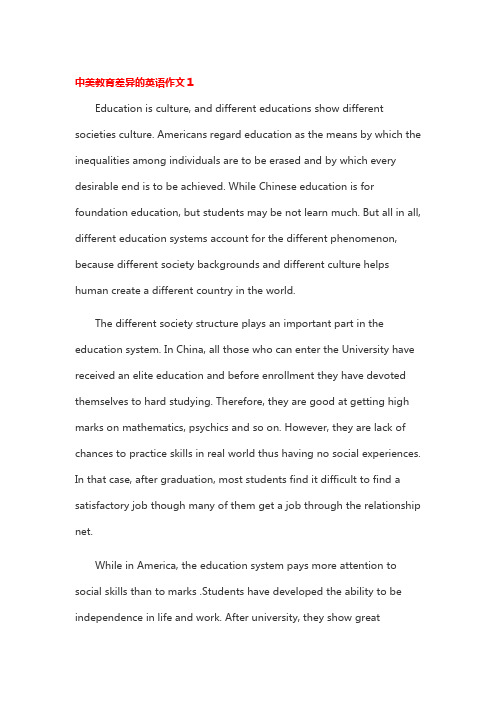
中美教育差异的英语作文1Education is culture, and different educations show different societies culture. Americans regard education as the means by which the inequalities among individuals are to be erased and by which every desirable end is to be achieved. While Chinese education is for foundation education, but students may be not learn much. But all in all, different education systems account for the different phenomenon, because different society backgrounds and different culture helps human create a different country in the world.The different society structure plays an important part in the education system. In China, all those who can enter the University have received an elite education and before enrollment they have devoted themselves to hard studying. Therefore, they are good at getting high marks on mathematics, psychics and so on. However, they are lack of chances to practice skills in real world thus having no social experiences. In that case, after graduation, most students find it difficult to find a satisfactory job though many of them get a job through the relationship net.While in America, the education system pays more attention to social skills than to marks .Students have developed the ability to be independence in life and work. After university, they show greatcapability of thinking, innovation and creation which make them keep pace with the modern world. They are competent for the challenging work and can gain a good job in America with ease.There is a huge gap on education between America and China, but we cant say which one is right or wrong, ‘cause each of the education system is based on the different backgrounds, American education should be following the Americans culture, meanwhile, Chinese education has to follow Chinese culture. A good education model for China is very important to the learning process, and also is very hard. But the most important thing we need is the modern education which is internationalization education system and localization education systems unite for China and America, this is also what the education itself needs.中美教育差异的英语作文2The Differences of Education between China and U.SBased on checking the extensive literature and summing up the evidence, it is clear that study about differences of higher education between China and US has carried out a lot which mainly explaines the differences from different aspects of higher edcation between China and the United States. Such aspects mainly includes the social environment and cultural tradition, higher education system and reform measures. Inthe Integration of these differences, advantages and evils of both educational systems have been evaluated respectively, and corresponding improvement measures were also put forwords. By summary, the detailed conclusions are listed as follows:US is a open society. The societys openness urges the American college to abandon old educational thoughts which European traditional universities stick to, adopt the open policy to absorb all advatanges from other countries and establishe a diverse and open education control system which emphasizes on the actual effect. US is the biggest imigrant country which has very strong containing nature in the culture. American economy ephiseizes on the practical value, matter rewards as well as individual value realization with fast development, rich material life, strong material idea and etc.Uss higher education was considered as the best education in the world. Comparing the elementary education between American and China, peoples universal view will be: Chinas elementary education aims to build the foundation of education with more study and less thought; while USs education aims to bulid such an education to raise the creativity with less study and more thought. Now Chinese students are generally regarded as intalents with few intelligence and high scores. What causes for such a view? Because the Chinese students study more,actually pay little attention to the practice, and cannot study for the purpose of application. Therefore, it is very important for Chinese higher education to cultivate the idea of unifying the study and prctice.USs education pays more attention to raise studentsself-confidence,independence,spirit of supporting oneself, but Chinas education emphases on training the students to be strict,rigorous spiritual.Obviously, Chinese education may fruitfully develop and ultilize the function of cerebrum, but USs higher education could expand the function of cerebrum by ultilizing and synthesizing the information outside.Each national higher education as economic systems reflection serves for the economy; US education aims to adapt for society demand, they explicitly stipulate three big functions including educations service for the economic development, scientific research and teaching. The manifest of service in the establishment of specialty curriculum is to meet the social need, set up special curriculum and specialty which the society needs; In Chinas universities, during quite long period of time, the establishment of specialty curriculum lacks the change and couldnot follow social demand.In order to adapt the society, the American universities has established many specialties and curriculum of choice for students; Thestudents choose or transformate specialties and schools according to own interest and hobby. The American higher education system is extremely diverse and flexible, which is solo in the world higher education; In China, the student may choose the specialty according to own interest and hobby, but change of specialty in the school is not easy, and transformation of school is more difficult.When American school inspects the result of student, they emphasize more on the ability to analyze and solve the question but not the ability of memory or description. The American students donot need the mechanical memorizing, but display creative thought as far as possible; This can cultivate students study interest, raise the ability of doing it byself and make the study be one kind of creative action.Many teachers still adopted old teaching ways in the Chinese universities, thus take a test which needs mechanical memorizing.Due to the development of science and technology, connections between higher education and national politics, economy,science,culture, military relation is day by day closer. The higher education is vigorous and upward, and it not only simply performances for the growth of quantity, but especially has had the huge change in the nature[1]. The advanced level of higher education has become a thesymbol of national strength.We should clarify the difference of higher education between China and American, at the same time absorb the advantges to profit from the American higher education so as to faster the reform andthe development of our higher education.中美教育差异的英语作文3Uss higher education was considered as the best education in the world.Comparing the elementary education between American and China, peoples universal view will be: Chinas elementary education aims to build the foundation of education with more study and less thought; while USs education aims to bulid such an education to raise the creativity with less study and more thought. Now Chinese students are generally regarded as intalents with few intelligence and high scores. intalents What causes for such a view? Because the Chinese students study more, actually pay little attention to the practice, and cannot study for the purpose of application. Therefore, it is very important for Chinese higher education to cultivate the idea of unifying the study and prctice.USs education pays more attention to raise studentsself-confidence,independence,spirit of supporting oneself, but Chinas education emphases on training the students to be strict,rigorous spiritual. Obviously, Chinese education may fruitfully develop and ultilizethe function of cerebrum, but USs higher education could expand the function of cerebrum by ultilizingand synthesizing the information outside.The American higher education system is extremely diverse and flexible, which is solo in the world higher education; In China, the student may choose the specialty according to own interest and hobby, but change of specialty in the school is not easy, and transformation of school is more difficult. When American school inspects the result of student, they emphasize more on the ability to analyze and solve the question but not the ability of memory or description.The American studentsdonot need the mechanical memorizing, but display creative thought as far as possible; This can cultivate students study interest, raise the ability of doing it byself and make the study be one kind of creative action. Many teachers still adopted old teaching ways in the Chinese universities, thus take a test which needs mechanical memorizing.American parents open education that:(1) pay attention to practical exercise, emphasize the child in practice, not a lecture.Americans believe that, every child, everything makes children yourself to finish in task in the process to improve knowledge, accumulate experience, master technology, enhance ability, raises theinterest expertise, and increase the confidence and sense of responsibility.(2) the value play games, americans think playing children this age is the most important thing.In the United States, children in the activities, sports activities time is abundant, activity places is everywhere.Parents often use holiday weekend, lead the child goes out to play, play in the process of developing intelligent such as perception, imagine, judgment, reasoning and human communication and the mood adjustment, etc.Chinese parents are enclosed education:(1) to preach to give priority to, the contempt practice activities the important role.The parents and children requirement is reading, even can provide for oneself by their parents wishes activities, and led to many Chinese children learned a lot of knowledge are useless, took to the society after what also cant.(2) outdoor activities less, because the Chinese children learn from morning till night dont finish homework do not over of homework, be homework overwhelmed; Sometimes even if want to move and is hard to find good site.。
中美教育差异中英文
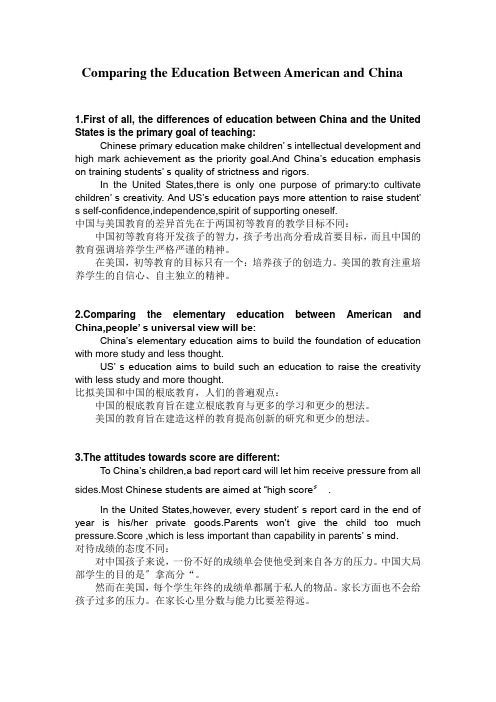
Comparing the Education Between American and China1.First of all, the differences of education between China and the United States is the primary goal of teaching:Chinese primary education make children’ s intellectual development and high mark a chievement as the priority goal.And China’s education emphasis on training students’ s quality of strictness and rigors.In the United States,there is only one purpose of primary:to cultivate children’ s creativity. And US’s education pays more attention to raise student’ s self-confidence,independence,spirit of supporting oneself.中国与美国教育的差异首先在于两国初等教育的教学目标不同:中国初等教育将开发孩子的智力,孩子考出高分看成首要目标,而且中国的教育强调培养学生严格严谨的精神。
在美国,初等教育的目标只有一个:培养孩子的创造力。
美国的教育注重培养学生的自信心、自主独立的精神。
paring the elementary education between American and China,people’ s universal view will be:China’s elementary education aims to build the foundation of education with more study and less thought.US’ s education aims to build such an education to raise the creativity with less study and more thought.比拟美国和中国的根底教育,人们的普遍观点:中国的根底教育旨在建立根底教育与更多的学习和更少的想法。
中国的教育Chinese,Education英语作文_2254

中国的教育Chinese,Education英语作文篇一:中国教育体制的弊端的英语作文中国教育体制的弊端的英语作文the disadvantage of the education in China,Talking about the education form:take [sit for] an examination,I have something to say.First this kind of education is notscientific,because the real education should include many aspects: not only the cultural knowledge on books,but also the developing of the morality、character,they need the principle of behavior as a civial.The physical quality,the mental quality,are all needed to be developped during the education.The education should be overall.The simple "taking for exam' kind of education can only produce students with high marks and short of social ability and principle of behaviour.These kinds of youths cannot be a qualified human beings because they lack the human qualities and civilization,they are more likely to be robots without soul,only know earning money by anyway.These are not good for the society篇二:谈中国教育问题英语作文What’s wrong with the education in China?ProblemsWhen I was a little kid,I was very interested in English,history and math.And I learnt a lot of things from English cartoons and historical movies.Albert Einstein said,”Interest is the best teacher.”.I like acquiring knowledge that I am concerned about by myself.This situation changed when I was in senior one.At that time my English grade was good but I don’t like English class because my teacher always talked about grammar and vocabulary.One day I was asked to write down some new words on the blackboard.I can’t finish it beca use I didn’t preview.After calss my teacher had a chat with me.I said I did’t like the way that teachers teached me.My teacher said,”I don’t like this way either but we teachers have to because of college entrance examination.This is the thing that you can’t avoid.So you can’t do everything you like because you are a Chinese student.”After listening to her words,I realized I had to give up my interests and fought for a good college.Luckily I changed my mind so I can be in SEU,but unluckily we lost our int erests. Some students didn’t changed and they couldn’t enter a good college.However,can we said they are bad students?Of course not.To get better grade,I swam in the sea of physics instead of history because we didn’t learn it.We also had some things in sc ience that don’t need to learn because college entrance examination don’t check here.To be honest,I always fight for my grade,not interest.ReasonsMy purpose is not to attack college entrance examination.The reason that we have to lose our interests is eolment rate.Every senior high school aspires higher eolment rate so that they can get fame and earn more money.High schools compare with other schools. Also parents put pressure on teachers.If their children don’t get good grades,they will blame these on teachers.Our teachers have to make leaders and parents satisfied,so they put pressure on us.This situation that grade is everything is not someone’s fault.I don’t mean that we should cancel exams.Instead,Ithink college entrance examination is the most fair way to compete.Now adults ask children,”How is your grades?”,not”What have you learnt?”.This reports that it’s a social problem.SolutionsI think that the government should pay more for children’s education and gradually eliminate education area differences.For example,Tsinghua University’s lowest criterion of examination in Beijing is much lower in Anhui.That means Anhui students have to pay much more effort to achieve the same goal.Also,parents need to know that grade is not everything and we should learn many things not only books.I believe ,with the development of China,the education in China will become real “quality education”.篇三:中国教育之现状英文写作一、教育机会的不公1.近年来,由于城乡差距、地区差距以及地区内校际教育资源的差别引发的“择校热”愈演愈烈,不少家长宁可花重金择校,也要让子女挤进重点学校。
中国和美国大学的不同英语作文
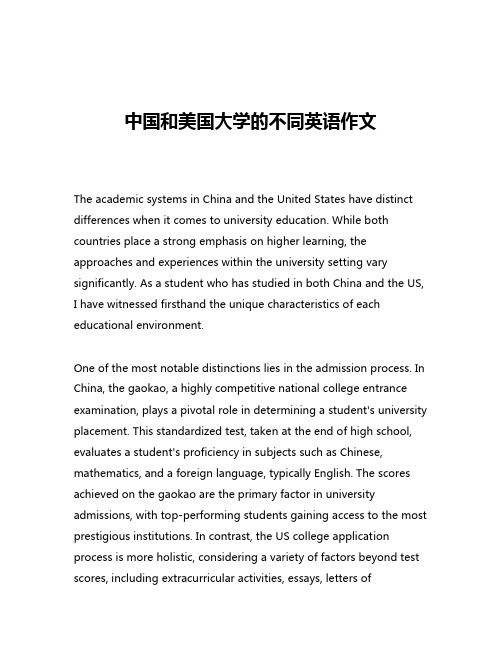
中国和美国大学的不同英语作文The academic systems in China and the United States have distinct differences when it comes to university education. While both countries place a strong emphasis on higher learning, the approaches and experiences within the university setting vary significantly. As a student who has studied in both China and the US, I have witnessed firsthand the unique characteristics of each educational environment.One of the most notable distinctions lies in the admission process. In China, the gaokao, a highly competitive national college entrance examination, plays a pivotal role in determining a student's university placement. This standardized test, taken at the end of high school, evaluates a student's proficiency in subjects such as Chinese, mathematics, and a foreign language, typically English. The scores achieved on the gaokao are the primary factor in university admissions, with top-performing students gaining access to the most prestigious institutions. In contrast, the US college application process is more holistic, considering a variety of factors beyond test scores, including extracurricular activities, essays, letters ofrecommendation, and sometimes interviews.Another key difference lies in the structure and curriculum of university programs. Chinese universities generally follow a more rigid and specialized approach, where students declare their major upon enrollment and take a predetermined set of courses within that field. The curriculum is often heavily focused on the chosen discipline, with limited opportunities for electives or interdisciplinary studies. In the US, however, the undergraduate experience is typically more flexible, with students required to fulfill general education requirements in a range of subjects before declaring a major. This allows for a broader exploration of academic interests and the cultivation of a well-rounded education.Classroom dynamics and teaching methodologies also vary significantly between the two educational systems. In China, lectures tend to be the primary mode of instruction, with professors delivering content in a more authoritative and didactic manner. Student participation is often limited, and the emphasis is placed on rote learning and memorization. In contrast, US universities generally encourage a more interactive and discussion-based approach, where students are expected to actively engage in class discussions, ask questions, and contribute their own ideas and perspectives. Professors in the US often employ a variety of teaching methods, including group projects, case studies, and hands-on learningexperiences.The role of extracurricular activities is another area where Chinese and American universities diverge. In China, the primary focus is on academic achievement, and extracurricular involvement is often seen as a secondary concern. Students may participate in some organized activities, such as sports teams or cultural clubs, but the emphasis is primarily on excelling in coursework and achieving high grades. Conversely, US universities place a significant emphasis on the holistic development of students, with a wide range of extracurricular opportunities available, from student organizations and volunteer work to internships and study abroad programs. Participation in these activities is often viewed as an essential component of the university experience, contributing to personal growth, leadership development, and a well-rounded education.The campus life and student experience also differ between the two educational systems. Chinese universities typically have a more self-contained campus environment, where students live, study, and socialize within the university grounds. The campus often features dormitories, dining halls, and recreational facilities, fostering a sense of community and camaraderie among the student body. In the US, however, the university experience is more integrated with the surrounding community, with students living both on and off campus, and having access to a broader range of resources andopportunities beyond the university grounds.Finally, the approach to student support and counseling also varies between China and the US. Chinese universities tend to have a more centralized and structured system of academic and personal support, with designated offices and staff responsible for advising students on course selection, career planning, and addressing any personal or psychological issues. In the US, the support system is often more decentralized, with various offices and services (such as academic advising, career counseling, and mental health resources) available to students, who are encouraged to take a more proactive role in accessing these resources as needed.In conclusion, the differences between Chinese and American universities reflect the distinct cultural, educational, and societal values of each country. While both systems strive to provide quality higher education, the approaches, experiences, and priorities within the university setting vary significantly. Understanding these differences can help students and educators appreciate the diverse perspectives and opportunities available in the global landscape of higher education.。
中美学前教育比较
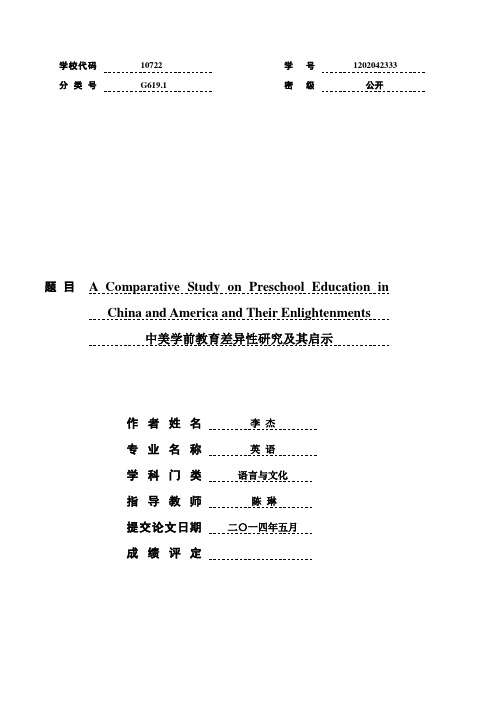
Contents
AComparative Study on Preschool Education inChinaandAmericaand Their Enlightenments
1.Introduction
Education is an essential project of fostering talents for a country, and is also an important public welfare thatinfluencesthousands of people’s livelihoods. Education plays averyimportant role inthedevelopment of both people and thewholesociety. Preschool education is thefoundationof elementary education and is anextremelyimportant component of the national education system.
2.Literature Review
Chen Heqin, who enjoys the reputation of “the father ofChina’spreschool education”, devoted his whole life and energy to preschool education. On the basis of inheriting the corevaluesand the basic spirit of traditional education,Chen Heqinputsforward his own educational goal thatthe goal ofactiveeducation is to make people learn to behave well, to be a real Chinese and to be a modern Chinese.Hestressesthatto be a modernChinesemeans being well equipped with sound body, constructive capacity, creative ability, cooperative attitude and theconsciousnessof serving the people(Chen 45).He also added thatchildren’seducationis a science.Only byunderstanding thechildrencan weteachthechildren.Practice makes perfect.We should explore the law for educating children from practice(Chen 587).Obviously,ChenHeqin’spreschool educationaims toprovide children withwaysappropriate to theirphysical and mental development.
英语作文带翻译:中国的教育ChineseEducation
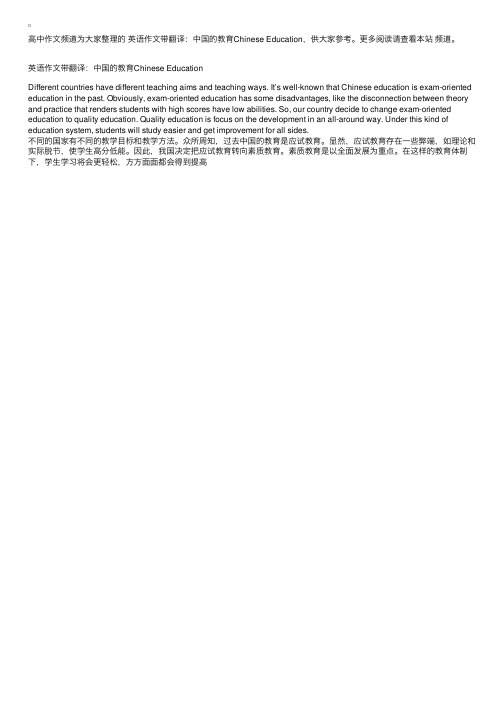
⾼中作⽂频道为⼤家整理的英语作⽂带翻译:中国的教育Chinese Education,供⼤家参考。
更多阅读请查看本站频道。
英语作⽂带翻译:中国的教育Chinese EducationDifferent countries have different teaching aims and teaching ways. It’s well-known that Chinese education is exam-oriented education in the past. Obviously, exam-oriented education has some disadvantages, like the disconnection between theory and practice that renders students with high scores have low abilities. So, our country decide to change exam-oriented education to quality education. Quality education is focus on the development in an all-around way. Under this kind of education system, students will study easier and get improvement for all sides.不同的国家有不同的教学⽬标和教学⽅法。
众所周知,过去中国的教育是应试教育。
显然,应试教育存在⼀些弊端,如理论和实际脱节,使学⽣⾼分低能。
因此,我国决定把应试教育转向素质教育。
素质教育是以全⾯发展为重点。
在这样的教育体制下,学⽣学习将会更轻松,⽅⽅⾯⾯都会得到提⾼。
The differences between Chinese and western education 中西方教育的不同
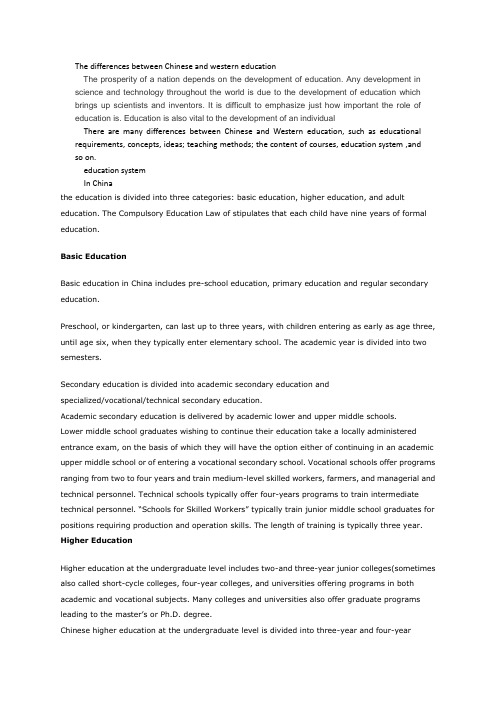
The differences between Chinese and western educationThe prosperity of a nation depends on the development of education. Any development in science and technology throughout the world is due to the development of education which brings up scientists and inventors. It is difficult to emphasize just how important the role of education is. Education is also vital to the development of an individualThere are many differences between Chinese and Western education, such as educational requirements, concepts, ideas; teaching methods; the content of courses, education system ,and so on.education systemIn Chinathe education is divided into three categories: basic education, higher education, and adult education. The Compulsory Education Law of stipulates that each child have nine years of formal education.Basic EducationBasic education in China includes pre-school education, primary education and regular secondary education.Preschool, or kindergarten, can last up to three years, with children entering as early as age three, until age six, when they typically enter elementary school. The academic year is divided into two semesters.Secondary education is divided into academic secondary education andspecialized/vocational/technical secondary education.Academic secondary education is delivered by academic lower and upper middle schools.Lower middle school graduates wishing to continue their education take a locally administered entrance exam, on the basis of which they will have the option either of continuing in an academic upper middle school or of entering a vocational secondary school. Vocational schools offer programs ranging from two to four years and train medium-level skilled workers, farmers, and managerial and technical personnel. Technical schools typically offer four-years programs to train intermediate technical personnel. “Schools for Skilled Workers” typically train junior middle school graduates for positions requiring production and operation skills. The length of training is typically three year. Higher EducationHigher education at the undergraduate level includes two-and three-year junior colleges(sometimes also called short-cycle colleges, four-year colleges, and universities offering programs in both academic and vocational subjects. Many colleges and universities also offer graduate programs leading to the master’s or Ph.D. degree.Chinese higher education at the undergraduate level is divided into three-year and four-yearprograms. The former is offered not only at short-cycle colleges, but frequently also at four-year colleges and universities. The latter is offered at four-year colleges and universities but do not always lead to the bachelor’s degree.Myriad higher education opportunities also fall under the general category of adult education. Adult EducationThe adult education category overlaps all three of the above categories. Adult primary education includes Workers’ Primary Schools, Peasants’ Primary Schools, and literacy classes. Adult secondary education includes radio/TV specialized secondary schools, specialized secondary school for cadres, specialized secondary schools for staff and workers, specialized secondary schools for peasants,in-service teacher training schools and correspondence specialized secondary schools. Adult higher education includes radio/TV universities, cadre institutes, workers’ colleges, peasant colleges, correspondence colleges, and educational colleges. Most of the above offer both two- and three-year short-cycle curricula; only a few also offer regular undergraduate curricula.In westThe American education system requires that students complete 12 years of primary and secondary education prior to attending university or college. This may be accomplished either at public (or government-operated) schools, or at private schools. These 12 years of schooling (or their equivalent) may also be completed outside the USA, thus giving foreign students the opportunity to pursue the benefits of the American education system and obtain a quality American education. Perhaps one of the most impressive facts is the large number of presidents, prime ministers and leaders from other countries who have experienced the American education system and graduated from a university or school in the USA. In many fields and industries, the American education system offers the most cutting-edge,sought-after programs at the world's best schools. That is why graduating from an accredited American school and being exposed to the rigors of the American education system is an investment in your future.Teaching methodsIn Chinateachers teach student according to the text books and their own knowledge . The education is based on the text book. All of the work to be done is in the text book and requires no additional research.Teachers are strict and emphasis the marks .From kindergarten, children are told to remember what they are taught. There is a widely accepted idea that whatever said by “teachers” or printed on books is unquestionable (in fact, no one would bother to question it, maybe because of laziness), and the teachers expect the students to do whatever they ask them to do. If the students doubt what the teachers said, the teachers will be embarrassed and offended. Students are allowed to asked questions which are closely related to what they are taught and which will be considered worth answering. If one’s question is too tricky, his teacher will be unhappy and may refuse to answer it. To put it simple, in China, students areexpected to “remember what it is”and don’t ask too many “why”s. The teachers’ teaching ability is judged according to the scores of the students.In westThings are different in western education system, where more emphasis is put on skills and creative thinking rather than learning by rote. Teachers are more active and are expected to interact with their students during classes, and it is believed that the more interactions there are during a class, the more valuable the lesson is. Questions, interruptions and even arguments from the students are greatly encouraged. The ways in which the students learn are more valued than the knowledge they gain fromclasses.It involves the text book, but many times, the students have to do research to answer some of the problems left by the teacher. THey would also be given assignments that can last over a few week to work on. In their exams, the test papers are created as a challenge for every student, so theoreatically, no one is supposed to be able to achieve 100 percent.PurposeChinese education is for knowledgeAmerican education is for the cultivation of students’ creativity.Conceptthere are two basic concepts of education value, teaching and guiding.Teaching concept is commonly used in Chinese Education System which is base on textbook contents. Students learn knowledge through classes that are conducted by teachers inside the classroom. Besides it is being used in Chinese family education; students perceive knowledge by listening to what the parents have told them and textbooks which parents ask them to read. This concept is well effected in raising so called “good student” who always abbeys rules and regulations, inheriting traditions and general habits. It resulted that Chinese primary education is with no doubt strongly-built, especially during primary school and middle school period. That is also the reason why Chinese students can win scores of prize in Olympic competitions every year.Guiding is the main concept of education wildly used in western countries. It emphasizes the rights and respects of children, which is base on a trust motion. Schools provide students with fulfilled self-management, support them to control themselves. At home, parents see children as one equal member of the family; they have identical duty and responsibility for the family. Western children have more freedom and private without much instruction; they are more persuaded by enlightening and leading. Westerners intend to offer children opportunities to develop themselves, discovering their potential specialties and abilities. They encourage children to study with interest under pleasure, doing what they want to do and trying the best they can. Thus western children are more responsible and confident; they have a higher grade of self-esteems because of the process of self-learning.Family educationIn Chinaparents always tell us that we should have the good manner of studying hard towards goals as a Chinese tradition. Most parents start teaching children simple calculating and writing when they are 3 or 4 years old. Almost every Chinese have the memory of being forced to Chinese ancient poems in their childhood. However, in the 21st century today, only reciting poems andtextbooks, expecting high scores in exam, studying without other activities are evidently limited for the multi-changed diversity world. It is even harm for teenagers if dominate their life by studying only, because the ability of innovation is eradicated.In Westpeople more look into children’s perceive abilities. In primary school, teachers conduct classes in discussion and games. Students have little homework but more handwork, they are studying under pleasure. All the subjects in middle school practice the point system, exams are only a small part of course module. Western students just have to keep sufficient attendance and points, they can graduate easily. They have the opportunity to manage their leisure time, develop their interests. We could obviously find out that western people are normally more positive and easy going. They have various knowledge about life and nature which is out of textbooks, also they have better communication skills to getting along with different people.FinancingIn ChinaThe government provides the main support and fund and it play a important role .The number of state school is more than private school and generally speaking ,state school is better than private school.In westThe government provides support while communities ,entrepreneur ,。
国学作文之中国学生与美国学生学习区别英语作文
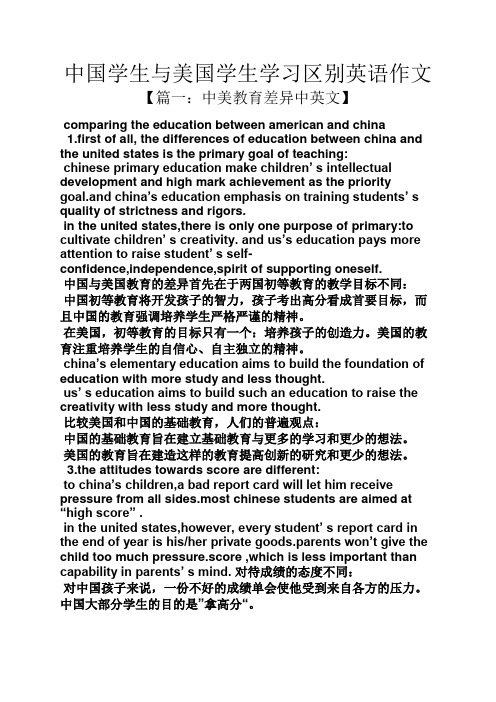
中国学生与美国学生学习区别英语作文【篇一:中美教育差异中英文】comparing the education between american and china1.first of all, the differences of education between china and the united states is the primary goal of teaching:chinese primary education make children’ s intellectual development and high mark achievement as the priority goal.and china’s education emphasis on training students’ s quality of strictness and rigors.in the united states,there is only one purpose of primary:to cultivate children’ s creativity. and us’s education pays more attention to raise student’ s self-confidence,independence,spirit of supporting oneself.中国与美国教育的差异首先在于两国初等教育的教学目标不同:中国初等教育将开发孩子的智力,孩子考出高分看成首要目标,而且中国的教育强调培养学生严格严谨的精神。
在美国,初等教育的目标只有一个:培养孩子的创造力。
美国的教育注重培养学生的自信心、自主独立的精神。
china’s elementary education aims to build the foundation of education with more study and less thought.us’ s education aims to build such an education to raise the creativity with less study and more thought.比较美国和中国的基础教育,人们的普遍观点:中国的基础教育旨在建立基础教育与更多的学习和更少的想法。
中西方教育差异英语作文
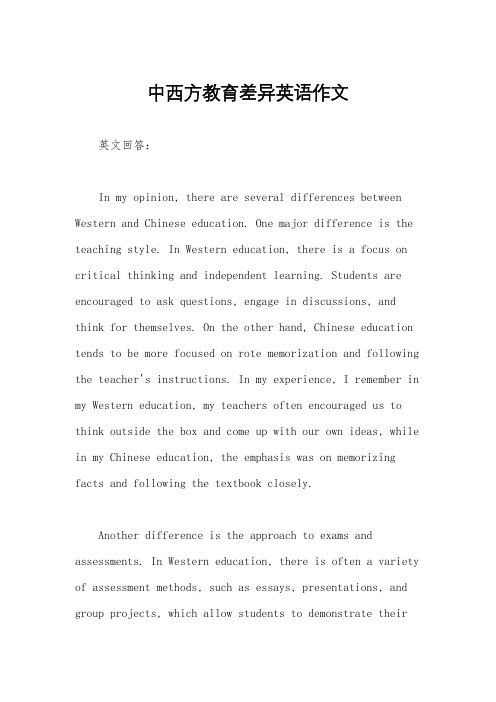
中西方教育差异英语作文英文回答:In my opinion, there are several differences between Western and Chinese education. One major difference is the teaching style. In Western education, there is a focus on critical thinking and independent learning. Students are encouraged to ask questions, engage in discussions, and think for themselves. On the other hand, Chinese education tends to be more focused on rote memorization and following the teacher's instructions. In my experience, I remember in my Western education, my teachers often encouraged us to think outside the box and come up with our own ideas, while in my Chinese education, the emphasis was on memorizing facts and following the textbook closely.Another difference is the approach to exams and assessments. In Western education, there is often a variety of assessment methods, such as essays, presentations, and group projects, which allow students to demonstrate theirunderstanding in different ways. In Chinese education, exams are the primary form of assessment, and there is a heavy emphasis on scoring well on standardized tests. For example, when I was studying in the West, I had the opportunity to do a group project where we had to research and present our findings, which was a great opportunity to work with my peers and develop my communication skills. On the other hand, in my Chinese education, I had to take multiple choice exams that tested my ability to recall information.中文回答:在我看来,中西方教育有几个不同之处。
更喜欢英式教育还是中国教育英语作文
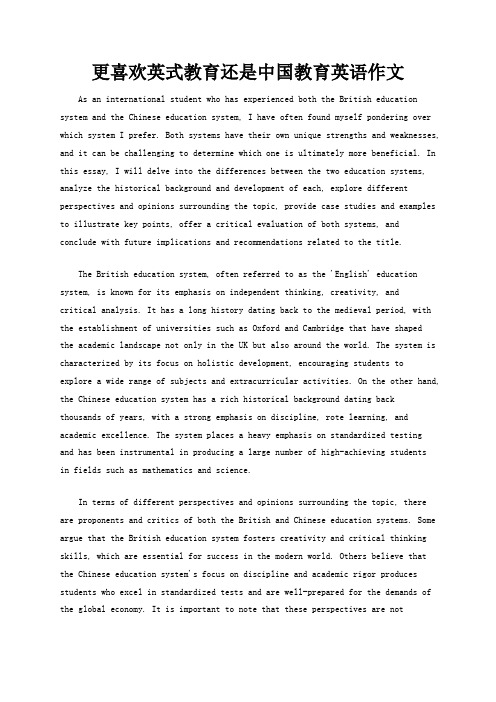
更喜欢英式教育还是中国教育英语作文As an international student who has experienced both the British education system and the Chinese education system, I have often found myself pondering over which system I prefer. Both systems have their own unique strengths and weaknesses, and it can be challenging to determine which one is ultimately more beneficial. In this essay, I will delve into the differences between the two education systems, analyze the historical background and development of each, explore different perspectives and opinions surrounding the topic, provide case studies and examples to illustrate key points, offer a critical evaluation of both systems, and conclude with future implications and recommendations related to the title.The British education system, often referred to as the 'English' education system, is known for its emphasis on independent thinking, creativity, andcritical analysis. It has a long history dating back to the medieval period, with the establishment of universities such as Oxford and Cambridge that have shapedthe academic landscape not only in the UK but also around the world. The system is characterized by its focus on holistic development, encouraging students toexplore a wide range of subjects and extracurricular activities. On the other hand, the Chinese education system has a rich historical background dating back thousands of years, with a strong emphasis on discipline, rote learning, and academic excellence. The system places a heavy emphasis on standardized testingand has been instrumental in producing a large number of high-achieving studentsin fields such as mathematics and science.In terms of different perspectives and opinions surrounding the topic, there are proponents and critics of both the British and Chinese education systems. Some argue that the British education system fosters creativity and critical thinking skills, which are essential for success in the modern world. Others believe that the Chinese education system's focus on discipline and academic rigor produces students who excel in standardized tests and are well-prepared for the demands of the global economy. It is important to note that these perspectives are notmutually exclusive, and there are elements of both systems that can be beneficial for students.To illustrate key points, let us consider the case of two students, one who has experienced the British education system and another who has experienced the Chinese education system. The former may have developed strong critical thinking skills and a passion for learning, while the latter may have excelled in subjects such as mathematics and science due to the rigorous academic training. Both students have unique strengths and weaknesses that are a result of their respective education systems, highlighting the diversity of skills and knowledge that can be cultivated through different approaches to education.A critical evaluation of both education systems reveals that while the British system excels in nurturing creativity and independent thinking, it may lack the discipline and academic rigor that is characteristic of the Chinese system. Conversely, the Chinese system may produce students who excel in standardizedtests but may struggle with creativity and critical thinking. It is clear that both systems have their own set of benefits and drawbacks, and it is important to recognize the value of a diverse range of skills and knowledge in today's interconnected world.Moving forward, it is crucial to consider the future implications and recommendations related to the title. As the world becomes increasingly interconnected, it is important for education systems to adapt and evolve to meet the demands of the modern world. Both the British and Chinese education systems can learn from each other's strengths and weaknesses, incorporating elements of creativity, critical thinking, discipline, and academic rigor to create a more holistic and balanced approach to education. By embracing a more diverse and inclusive education system, students can be better prepared to navigate the complexities of the 21st century.In conclusion, the debate over whether one prefers the British or Chinese education system is a complex and multifaceted issue. Both systems have their ownunique strengths and weaknesses, and it is important to recognize the value of a diverse range of skills and knowledge. By critically evaluating both systems, considering different perspectives and opinions, and offering future implications and recommendations, we can work towards creating a more inclusive and balanced approach to education that prepares students for success in the modern world.。
中国和西方教育的差异英语演讲汇报

• Family Education
• Western parents pay much attention to children’s own exercise. Instead of designing the future for their children, they value the free development of children and try their best to make them develop into a social person that can adapt to various kinds of environment and have the ability to survive in this severe society. They hope that through their family education, their children can develop a pioneering spirit and be able to rely on themselves.
中国教育和外国教育的区别英语作文
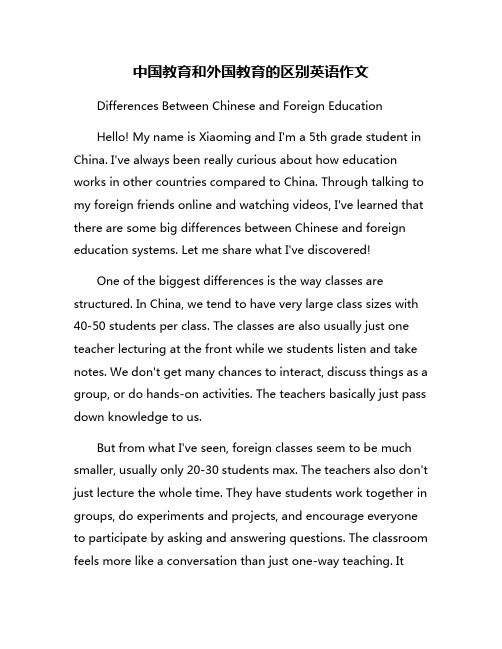
中国教育和外国教育的区别英语作文Differences Between Chinese and Foreign EducationHello! My name is Xiaoming and I'm a 5th grade student in China. I've always been really curious about how education works in other countries compared to China. Through talking to my foreign friends online and watching videos, I've learned that there are some big differences between Chinese and foreign education systems. Let me share what I've discovered!One of the biggest differences is the way classes are structured. In China, we tend to have very large class sizes with 40-50 students per class. The classes are also usually just one teacher lecturing at the front while we students listen and take notes. We don't get many chances to interact, discuss things as a group, or do hands-on activities. The teachers basically just pass down knowledge to us.But from what I've seen, foreign classes seem to be much smaller, usually only 20-30 students max. The teachers also don't just lecture the whole time. They have students work together in groups, do experiments and projects, and encourage everyone to participate by asking and answering questions. The classroom feels more like a conversation than just one-way teaching. Itseems like students in other countries get more opportunities to be creative, explore ideas, and learn in an interactive way.Another difference is the focus on testing and scores. In China, we have these huge, make-or-break exams like the zhongkao and gaokao that determine our entire future. From a very young age, there is immense pressure to score well on tests in order to get into good schools. A lot of the learning is oriented around preparing for these exams by memorizing facts and formulas. I often feel like I'm just studying to be a goodtest-taker rather than really understanding the deeper concepts.But I've heard that foreign education doesn't necessarily put as much emphasis on high-stakes testing and scores. The tests are still important, but just one part of evaluating a student's overall performance and understanding. More importance is placed on projects, participation, and demonstrating true mastery of skills and ideas compared to just drilling for exams. It seems like there is more room to learn at your own pace without the extreme test pressure we face in China.Schedules and extracurriculars are quite different too. At my school, we basically spend the entire day, from morning until evening, just doing intense academic classes like math, Chinese, English, science, etc. We have very little time for anything otherthan core academics during the regular school day and schedule. Any extracurriculars like sports, music, art, or clubs would have to be done outside of school hours.However, from what I can tell, foreign schools integrate more of those "non-academic" activities right into the normal school schedule and day. Students get periods for art, music, theater, P.E., and have time to participate in school clubs and sports teams as official parts of their week. Education seems to be more about developing a variety of skills and interests, rather than just intense academics all day long like it is for me. I wish I had more time during my regular week for creative outlets, sports, and exploring hobbies at school.One more major contrast is the teaching and discipline styles. In China, teachers have a very strict, authority-based role in the classroom. We are expected to show complete obedience and deference to the teacher's instructions. Classes have a very serious, rigid atmosphere where making mistakes or acting out of line is heavily criticized. We basically just receive information from the teacher as experts and aren't supposed to question or think too independently.But again, I've noticed teachers in many other countries seem to have a more casual, friendly rapport with their students.Don't get me wrong, they still maintain control and respect in the classroom. But students seem more comfortable expressing themselves, offering opinions, and challenging ideas in a respectful way. The teachers act more as guides who encourage critical thinking rather than just lecturing facts. There is also less harsh discipline and more of a focus on positive reinforcement compared to public discipline we might get in China.Those are some of the biggest differences I've picked up on between Chinese education and how schools operate in places like the U.S., Canada, Australia, and Europe. Of course, this is just based on my observations as a 10-year-old. And I'm sure there are also many similarities that education shares globally too. Every system has its own strengths and things it could improve.I can see pros and cons to both the Chinese and foreign approaches. The Chinese way has developed my skills like discipline, hard work, and being able to study intensively. But the foreign systems seem to create more creative, independent thinkers who are well-rounded. I almost wish I could experience a mix of both styles to get the best of both worlds! An education that pushed me academically while also giving me more freedom for hands-on learning, developing interests, and thinking critically.Either way, I feel pretty lucky。
Chinese education 中国式教育

Chinese education
Chinese students often start preschool as young as three years old and do not eபைடு நூலகம்ter elementary school until they are six. Chinese believe that this time is crucial to personality development. Students are taught to play games, to dance, to sing, to act and to uphold the values of Truth, Kindness and Beauty.
Chinese education
China currently provides free university education. Students do not have to pay tuition fee and are provided with free on-campus dormitories. Grants or subsidies will be given to students whose families have financial difficulties.
Chinese education
Students have to complete both the primary school program and the junior middle-school program. Higher education is only for those students who have passed examinations of all levels. Student must pass the entrance examination for senior middle schools or middle-level technical schools. Many contests are organized annually in all levels to encourage their study. After two, three or four years, they have to go through national college entrance examination for admission to universities.
Chinese Education中国教育
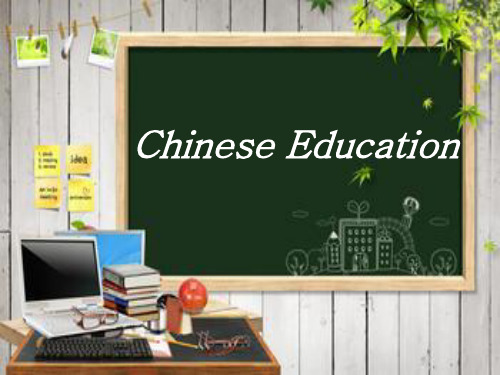
• 2005-2014, published more than 789 papers in provincial above, research projects for more than 157, won five provincial and ministerial level over the social science and natural science outstanding achievement award
If a student want to go to a competitive university. They need to obtain good marks on entrance examination scores and the have to pay a lots of effort.
• In 1989 ,the State Education Commission decided to implement the standardized test.(推行标准化考试)
• In 1996, implement the tuition consolidation and the tuition began to increase.(施行并轨招生) • In 2014,to reduce the examination subjects , Foreign language implemented several times every years(减少考试科目,外语一年多考)
school motto
“至善至美,自立自强”
理工大楼
微澜湖
图书馆
樱花坡
In this six years ,student usually learn these courses:
the difference between Chinese education and western education
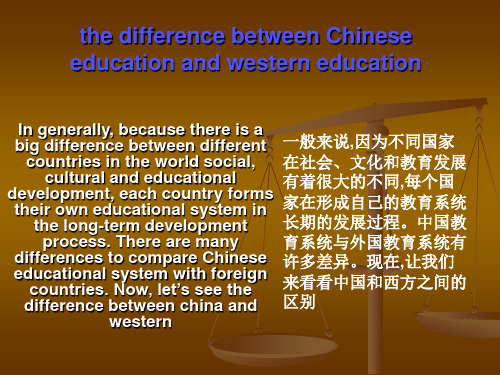
American care more about how students use knowledge in society. It lets student challenge the knowledge, animadvert ideas, and focus on, exploit or create knowledge.
What the China’s traditional culture grasps is life and morals, so the Chinese value life and the human relations extremely. Therefore, the Chinese teacher have regarded the morals as the highest value orientation in the education. Especially, in the Chinese mind, “the good child” is a child who is obedient and sensible . In that case, the parents trains the child to practice the moral culture, cultivates mental poise, self-restraining and the idea of social rank. The main connotation of Chinese school education is “the mercy, righteousness, the ritual, the wisdom, the honesty, loyalty, forgiveness
中国的教育Chinese,Education英语作文
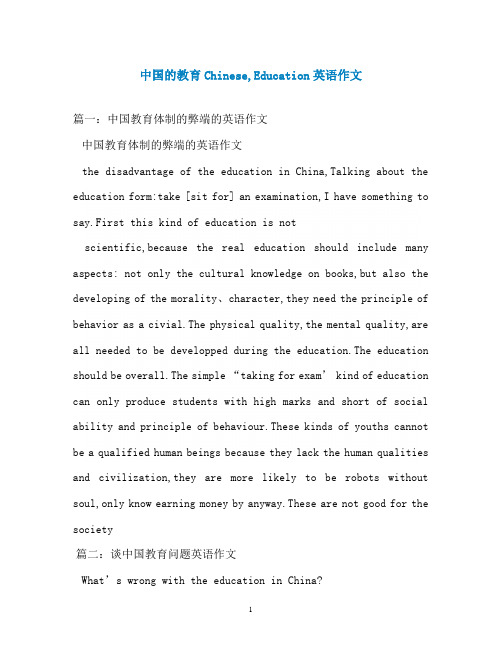
中国的教育Chinese,Education英语作文篇一:中国教育体制的弊端的英语作文中国教育体制的弊端的英语作文the disadvantage of the education in China,Talking about the education form:take [sit for] an examination,I have something to say.First this kind of education is notscientific,because the real education should include many aspects: not only the cultural knowledge on books,but also the developing of the morality、character,they need the principle of behavior as a civial.The physical quality,the mental quality,are all needed to be developped during the education.The education should be overall.The simple “taking for exam’ kind of education can only produce students with high marks and short of social ability and principle of behaviour.These kinds of youths cannot be a qualified human beings because they lack the human qualities and civilization,they are more likely to be robots without soul,only know earning money by anyway.These are not good for the society篇二:谈中国教育问题英语作文What’s wrong with the education in China?ProblemsWhen I was a little kid,I was very interested in English,history and math.And I learnt a lot of things from English cartoons and historical movies.Albert Einstein said,”Interest is the best teacher.”.I like acquiring knowledge that I am concerned about by myself.This situation changed when I was in senior one.At that time my English grade was good but I don’t like English class because my teacher always talked about grammar and vocabulary.One day I was asked to write down some new words on the blackboard.I can’t finish it because I didn’t preview.After calss my teacher had a chat with me.I said I did’t like the way that teachers teached me.My teacher said,”I don’t like this way either but we teachers have to because of college entrance examination.This is the thing that you can’t avoid.So you can’t do everything you like because you are a Chinese student.”After listening to her words,I realized I had to give up my interests and fought for a good college.Luckily I changed my mind so I can be in SEU,but unluckily we lost our interests. Some students didn’t changed and they couldn’t enter a goodcollege.However,can we said they are bad students?Of course not.To get better grade,I swam in the sea of physics instead of history because we didn’t learn it.We also had some things in science that don’t need to learn because college entrance examination don’t check here.To be honest,I always fight for my grade,not interest. ReasonsMy purpose is not to attack college entrance examination.The reason that we have to lose our interests is eolment rate.Every senior high school aspires higher eolment rate so that they can get fame and earn more money.High schools compare with other schools. Also parents put pressure on teachers.If their children don’t get good grades,they will blame these on teachers.Our teachers have to make leaders and parents satisfied,so they put pressure on us.This situation that grade is everything is not someone’s fault.I don’t mean that we should cancel exams.Instead,I think college entrance examination is the most fair way to compete.Now adults ask children,”How is your grades?”,not”What have you learnt?”.This reports that it’s a social problem. SolutionsI think that the government should pay more for children’seducation and gradually eliminate education area differences.For example,Tsinghua University’s lowest criterion of examination in Beijing is much lower in Anhui.That means Anhui students have to pay much more effort to achieve the same goal.Also,parents need to know that grade is not everything and we should learn many things not only books.I believe ,with the development of China,the education in China will become real “quality education”.篇三:中国教育之现状英文写作一、教育机会的不公1.近年来,由于城乡差距、地区差距以及地区内校际教育资源的差别引发的“择校热”愈演愈烈,不少家长宁可花重金择校,也要让子女挤进重点学校。
中西方教育理念的英语作文

Education is a cornerstone of societal development,and it varies significantly across different cultures.The Chinese and Western educational systems,in particular,have distinct approaches and philosophies that shape the way students are taught and learn.Chinese Educational Philosophy1.Emphasis on Respect for Authority:In Chinese education,there is a strong emphasis on respecting teachers and elders.Students are expected to follow instructions without question,which fosters a disciplined learning environment.2.Rote Learning:Memorization is a key component of Chinese education.Students are often required to memorize large amounts of information,which is seen as a way to builda solid foundation in various subjects.3.HighStakes Testing:Examinations play a crucial role in the Chinese education system. Highstakes tests,such as the Gaokao for university entrance,determine a students future academic and career opportunities.4.Collectivism:The Chinese educational system promotes a collective mindset,where the groups success is prioritized over individual achievements.This approach encourages teamwork and cooperation among students.5.Focus on Academic Excellence:Academic performance is highly valued,and students are pushed to excel in their studies.This focus on academic success can sometimes lead to intense competition among students.Western Educational Philosophy1.Emphasis on Individualism:Western education places a strong emphasis on individualism.Students are encouraged to express their opinions and think independently, fostering creativity and critical thinking skills.2.StudentCentered Learning:The learning process in Western education is often centered around the students interests and needs.Teachers adapt their teaching methods to cater to the diverse learning styles of their students.3.InquiryBased Learning:Western education encourages students to ask questions and explore subjects in depth.This approach helps students develop a deeper understanding of the material and promotes a love for learning.4.Emphasis on Practical Application:There is a focus on applying theoretical knowledge to realworld situations.Projects,internships,and handson activities are common, allowing students to see the relevance of their education.5.Balanced Approach to Learning:Western education aims to provide a wellrounded education,with equal importance given to academics,arts,sports,and social development.Comparative AnalysisCultural Values:Chinese education is deeply rooted in Confucian values,which emphasize respect for authority and the importance of education for social mobility. Western education,on the other hand,is influenced by a variety of philosophical traditions that value individual freedom and personal development.Teaching Methods:Chinese classrooms are often teachercentered,with a focus on direct instruction and lecturestyle teaching.Western classrooms tend to be more interactive, with an emphasis on discussion and collaborative learning.Student Outcomes:While Chinese students often excel in international academic competitions and standardized tests,Western students may be more likely to develop skills in creativity,problemsolving,and independent thinking.Adaptability:Western education may prepare students better for a rapidly changing global economy that values innovation and adaptability.However,the rigorous academic training in the Chinese system can produce deep expertise in specific fields.In conclusion,both Chinese and Western educational philosophies have their merits and drawbacks.A balanced approach that incorporates the strengths of both systems could potentially offer the best educational experience,preparing students to thrive in an increasingly interconnected and competitive world.。
- 1、下载文档前请自行甄别文档内容的完整性,平台不提供额外的编辑、内容补充、找答案等附加服务。
- 2、"仅部分预览"的文档,不可在线预览部分如存在完整性等问题,可反馈申请退款(可完整预览的文档不适用该条件!)。
- 3、如文档侵犯您的权益,请联系客服反馈,我们会尽快为您处理(人工客服工作时间:9:00-18:30)。
But in the United States, teachers will not do it in such way. The reason is that they think the test scores are private. Actually, American teachers also declare the results of the test. But they will write down the students’ ID numbers instead of the names.
Nowadays, many schools in our country still carry out the educational style-lecture teaching(授受式 ( 教学方式) 教学方式). This kind of teaching style focuses on book knowledge. What we can see in class is that teachers say and ask while students listen and answer. And students always study in the classroom. This kind of teaching style is harmful for students to widen their vision and broaden their minds.
US
Chinese
பைடு நூலகம்VS
Example: Example: A Cinderella Story 灰姑娘的故事
For the common use of the guiding concept of education(教育指导理念) in the United States, schools there provide students with fulfilled self-management and support them to control themselves. They emphasize more on the creativity and imagination of the students. Manual Training Course 劳作课 However, this overindulgence(过度放任) of teaching can lead to the laziness among students. Even some fourth
Rote-learning with this However, 死记硬背的学习方法 Spoon-fed can gain Test papers of weEducation teaching concept, a year that can circle
systemic knowledge and form a good habit of memorizing things.
In China, the relationship between the teacher and the student is very serious and formal. Politeness, respect and admiration from the students are of great importance to the teachers. It said that teachers often praise (表扬)less while criticize more because they take students’ doing well for granted (认为理当如此). However, sometimes it is thought that the teacher occupys a commending (居高临下的)position, which leads to long sense of distance between teachers and students.
Is the Test Score Private?
Chinese VS US
In China, declaring the results of the test, teachers always plaster the transcripts on the wall. As a result, everyone can look at each other’s result, and they can know who gets the highest or the lowest mark.
But in the United States, self-governing education(自治式教育 is so popular. Students are 自治式教育) 自治式教育 given more chances to do what they are interested in, what they are willing to do and to explore their own life path. In the class, teachers don’t focus more on book knowledge. Different kinds of books just play a subsidiary role in learning. And teachers just talk less than 10 minutes, and during the short time still remaining, students will communicate and exchange their own ideas.
Text Book: Page 104
the Aims of Education:
Chinese VS US
In China, schools have a unified goal which aims at feeding the students into middle schools, high schools, and then into the universities. But in the United States, schools aim at putting students into different levels of education for further training.
Film Festival & Role Playing Cooking Team
Acting or fifth grade primary school pupils are unable to memorize Class the multiplication table(九九乘法表).
Regarded as an exam-oriented education(应试教育), Chinese education pays more attention to the accumulation of knowledge, cultivating(培养) the students’ respect to the knowledge and authority.
around填鸭式教育 the earth about three times.
US
Chinese
师 长
VS
In the United States, it seems that they don’t care much about the concept of politeness. Students just address their teachers without particular titles. In fact, most of them are willing to regard each other as friends. They often chat casually, and even play jokes with their principals in the family way.
